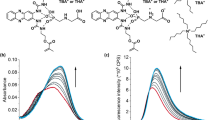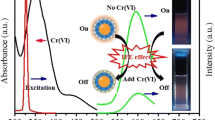Abstract
A sensitive molecularly imprinted fluorescent nanosensor based on zeolitic imidazolate frameworks-8 (ZIF-8) and upconversion nanoparticles (UCNPs) was developed for the determination of trace alpha-cypermethrin (α-CPM) for the first time. The sensor was synthesized by a layer-by-layer self-assembly strategy. UCNPs with a maximum emission wavelength of 544.5 nm under 980 nm excitation were firstly prepared as the luminous core. Then, ZIF-8 with the large specific surface and porosity was introduced, which not only improved the mass transfer and adsorption capacity of the sensor but also increased the fluorescence intensity of UCNPs as a protective layer. Finally, molecularly imprinted polymers (UCNPs@ZIF-8@MIPs) were fabricated in mixed solutions containing UCNPs@ZIF-8 (support material), α-CPM (template), acrylamide (functional monomer), and divinylbenzene (cross-linker). Under the optimal condition, the fluorescence intensity of UCNPs@ZIF-8@MIP was linearly quenched with increasing concentration of α-CPM in the range 0.10–12 mg L−1 with a detection limit of 0.03 mg L−1 (S/N = 3). The developed UCNPs@ZIF-8@MIP probe was used to detect α-CPM in real samples; the satisfactory results obtained were consistent with those obtained by GC-MS.
Graphical abstract




Similar content being viewed by others
References
Zhao M, Ma X, Zhao F, Guo H (2016) Molecularly imprinted polymer silica monolith for the selective extraction of alpha-cypermethrin from soil samples. J Mater Sci 51(7):3440–3447. https://doi.org/10.1007/s10853-015-9661-1
Diao J, Xu P, Liu D, Lu Y, Zhou Z (2011) Enantiomer-specific toxicity and bioaccumulation of alpha-cypermethrin to earthworm Eisenia fetida. J Hazard Mater 192(3):1072–1078. https://doi.org/10.1016/j.jhazmat.2011.06.010
Xu Z, Shen X, Zhang XC, Liu W, Yang F (2015) Microbial degradation of alpha-cypermethrin in soil by compound-specific stable isotope analysis. J Hazard Mater 295:37–42. https://doi.org/10.1016/j.jhazmat.2015.03.062
Zhang J, Gao H, Peng B, Li S, Zhou Z (2011) Comparison of the performance of conventional, temperature-controlled, and ultrasound-assisted ionic liquid dispersive liquid–liquid microextraction combined with high-performance liquid chromatography in analyzing pyrethroid pesticides in honey samples. J Chromatogr A 1218(38):6621–6629. https://doi.org/10.1016/j.chroma.2011.07.102
Ghani SBA, Hanafi AH (2016) QuEChERS method combined with GC–MS for pesticide residues determination in water. J Anal Chem 71(5):508–512. https://doi.org/10.1134/S1061934816050117
Wu S, Liu L, Duan N, Wang W, Yu Q, Wang Z (2018) A test strip for ochratoxin a based on the use of aptamer-modified fluorescence upconversion nanoparticles. Microchim Acta 497:1–8. https://doi.org/10.1007/s00604-018-3022-0
Wang W, Zhao M, Wang L, Chen H (2019) Core-shell upconversion nanoparticles of type NaGdF4:Yb,Er@NaGdF4:Nd, Yb and sensitized with a NIR dye are a viable probe for luminescence determination of the fraction of water in organic solvents. Microchimica Acta 186:630. https://doi.org/10.1007/s00604-019-3744-7
Ma Y, Ji Y, You M, Wang S, Dong Y, Jin G, Lin M, Wang Q, Li A, Zhang X (2016) Labeling and long-term tracking of bone marrow mesenchymal stem cells in vitro using NaYF 4 :Yb 3+ ,Er 3+ upconversion nanoparticles. Acta Biomater 42:199–208. https://doi.org/10.1016/j.actbio.2016.07.030
Tian Y, Li Y, Jiang W, Zhou D, Fei J, Li C (2019) In-situ imaging of azoreductase activity in the acute and chronic ulcerative colitis mice by a near-infrared fluorescent probe. Anal Chem 91:10901–10907. https://doi.org/10.1021/acs.analchem.9b02857
Jiang W, Li Y, Wang W, Zhao Y, Fei J, Li C (2019) A hepatocyte-targeting near-infrared ratiometric fluorescent probe for monitoring peroxynitrite during drug-induced hepatotoxicity and its remediation. Chem Commun 55:14307–14310. https://doi.org/10.1039/C9CC07017F
Zhao X, Wang C, Yuan G, Ding H, Zhou L, Liu X, Lin Q (2019) A dual-site modulated FRET-based two-photon ratiometric fluorescent probe for tracking lysosomal pH changes in living cells, tissues and zebrafish. Sensors Actuators B Chem 290:79–86. https://doi.org/10.1016/j.snb.2019.03.122
Drees C, Raj AN, Kurre R, Busch KB, Haase M, Piehler J (2016) Engineered upconversion nanoparticles for resolving protein interactions inside living cells. Angew Chem Int Ed 55(38):11668–11672. https://doi.org/10.1002/anie.201603028
Guo T, Deng Q, Fang G, Yun Y, Hu Y, Wang S (2016) A double responsive smart upconversion fluorescence sensing material for glycoprotein. Biosens Bioelectron 85:596–602. https://doi.org/10.1016/j.bios.2016.05.056
Yang L, Sun H, Wang X, Yao W, Zhang W, Jiang L (2019) An aptamer based aggregation assay for the neonicotinoid insecticide acetamiprid using fluorescent upconversion nanoparticles and DNA functionalized gold nanoparticles. Microchim Acta 308:1–11. https://doi.org/10.1007/s00604-019-3422-9
Jin X, Fang G, Pan M, Yang Y, Bai X, Wang S (2017) A molecularly imprinted electrochemiluminescence sensor based on upconversion nanoparticles enhanced by electrodeposited rGO for selective and ultrasensitive detection of clenbuterol. Biosens Bioelectron 102:357–364. https://doi.org/10.1016/j.bios.2017.11.016
Tong R, Hu X, Fang G, Sun S, Liu J, Wang S (2017) Rapid detection of hexamethylenetetramine based on the substrate UC@SiO 2 @Au@Ag using SERS. RSC Adv 7(79):49969–49974. https://doi.org/10.1039/c7ra07634g
Li Y, Zhang H, Cai X, Zhao H, Lan M (2019) Electrochemical detection of superoxide anions in HeLa cells by using two enzyme-free sensors prepared from ZIF-8-derived carbon nanomaterials. Microchim Acta 186(6):370. https://doi.org/10.1007/s00604-019-3473-y
Liu M, Fan B, Shi X, Li R (2013) Ru/ZIF-8 with a chiral modifier for asymmetric hydrogenation of acetophenone. Catal Commun 42(23):20–24. https://doi.org/10.1016/j.catcom.2013.07.038
Yin Y, Hu B, Li X, Zhou X, Hong X, Liu G (2018) Pd@zeolitic imidazolate framework-8 derived PdZn alloy catalysts for efficient hydrogenation of CO2 to methanol. Applied catalysis B environmental:S0926337318303539. https://doi.org/10.1016/j.apcatb.2018.04.024
Fairen-Jimenez D, Moggach SA, Wharmby MT, Wright PA, Parsons S, Düren T (2011) Opening the gate: framework flexibility in ZIF-8 explored by experiments and simulations. J Am Chem Soc 133(23):8900–8902. https://doi.org/10.1021/ja202154j
Wang Z, Yu G, Xia J, Zhang F, Liu Q (2018) One-step synthesis of a methylene blue@ZIF-8-reduced graphene oxide nanocomposite and its application to electrochemical sensing of rutin. Microchim Acta 185(5):279. https://doi.org/10.1007/s00604-018-2796-4
He L, Wang T, An J, Li X, Zhang L, Li L, Li G, Wu X, Su Z, Wang C (2014) Carbon nanodots@zeolitic imidazolate framework-8 nanoparticles for simultaneous pH-responsive drug delivery and fluorescence imaging. Crystengcomm 16(16):3259–3263. https://doi.org/10.1039/c3ce42506a
Wang K, Li N, Zhang J, Zhang Z, Dang F (2017) Size-selective QD@MOF core-shell nanocomposites for the highly sensitive monitoring of oxidase activities. Biosens Bioelectron 87:339–344. https://doi.org/10.1016/j.bios.2016.08.026
Xu L, Fang G, Liu J, Pan M, Wang R, Wang S (2016) One-pot synthesis of nanoscale carbon dots-embedded metal–organic frameworks at room temperature for enhanced chemical sensing. J Mater Chem A 4(41):15880–15887. https://doi.org/10.1039/c6ta06403e
Liu C, Yan B (2012) Photofunctional nanocomposites based on the functionalization of metal–organic frameworks by up/down conversion luminescent nanophosphors. New J Chem 39(2):1125–1131. https://doi.org/10.1039/c4nj01496k
Wagner R, Wan W, Biyikal M, Benito-Peña E, Moreno-Bondi MC, Lazraq I, Rurack K, Sellergren B (2013) Synthesis, spectroscopic, and analyte-responsive behavior of a polymerizable naphthalimide-based carboxylate probe and molecularly imprinted polymers prepared thereof. J Org Chem 78(4):1377–1389. https://doi.org/10.1021/jo3019522
Tan K, Ma Q, Luo J, Xu S, Zhu Y, Wei W, Liu X, Gu Y (2018) Water-dispersible molecularly imprinted nanohybrids via co-assembly of carbon nanotubes with amphiphilic copolymer and photocrosslinking for highly sensitive and selective paracetamol detection. Biosens Bioelectron 117:713–719. https://doi.org/10.1016/j.bios.2018.07.009
Huang J, Wu Y, Cong J, Luo J, Liu X (2017) Selective and sensitive glycoprotein detection via a biomimetic electrochemical sensor based on surface molecular imprinting and boronate-modified reduced graphene oxide. Sensors & Actuators B Chemical 259:1–9. https://doi.org/10.1016/j.snb.2017.12.049
Habibeh E, Maliheh A, Hamideh A, Javad H, Alizadeh EP (2018) MIP-capped terbium MOF-76 for the selective fluorometric detection of cefixime after its preconcentration with magnetic graphene oxide. Sensors Actuators B Chem 275:145–154. https://doi.org/10.1016/j.snb.2018.08.050
Guo T, Deng Q, Fang G, Gu D, Yang Y, Wang S (2016) Upconversion fluorescence metal-organic frameworks thermo-sensitive imprinted polymer for enrichment and sensing protein. Biosens Bioelectron 79:341–346. https://doi.org/10.1016/j.bios.2015.12.040
Xu L, Pan M, Fang G, Wang S (2019) Carbon dots embedded metal-organic framework@molecularly imprinted nanoparticles for highly sensitive and selective detection of quercetin. Sensors Actuators B Chem 286:321–327. https://doi.org/10.1016/j.snb.2019.01.156
Li Z, Zhang Y (2008) An efficient and user-friendly method for the synthesis of hexagonal-phase NaYF(4):Yb, Er/Tm nanocrystals with controllable shape and upconversion fluorescence. Nanotechnology 19(34):1–5. https://doi.org/10.1088/0957-4484/19/34/345606
Chowdhuri AR, Laha D, Pal S, Karmakar P, Sahu SK (2016) One-Pot Synthesis of Folic Acid Encapsulated Upconversion Nanoscale Metal Organic Frameworks for Targeting, Imaging and pH Responsive Drug Release. Dalton Transactions:1–37. https://doi.org/10.1039/C6DT03237K
Wang J, Qiu H, Shen H, Pan J, Dai X, Yan Y, Pan G, Sellergren B (2016) Molecularly imprinted fluorescent hollow nanoparticles as sensors for rapid and efficient detection λ-cyhalothrin in environmental water. Biosens Bioelectron 85:387–394. https://doi.org/10.1016/j.bios.2016.05.041
Li J, Zhang C, Yin M, Zhang Z, Chen Y, Deng Q, Wang S (2019) Surfactant-sensitized covalent organic frameworks-functionalized lanthanide-doped nanocrystals: an ultrasensitive sensing platform for perflfluorooctane sulfonate. ACS Omega 4:15947–15955. https://doi.org/10.1021/acsomega.9b01996
Wei X, Hao T, Xu Y, Lu K, Li H, Yan Y, Zhou Z (2016) Facile polymerizable surfactant inspired synthesis of fluorescent molecularly imprinted composite sensor via aqueous CdTe quantum dots for highly selective detection of λ-cyhalothrin. Sensors & Actuators B Chemical 224:315–324. https://doi.org/10.1016/j.snb.2015.10.048
Xiao T, Shi X, Jiao H, Sun A, Ding H, Zhang R, Pan D, Li D, Chen J (2016) Selective and sensitive determination of cypermethrin in fish via enzyme-linked immunosorbent assay-like method based on molecularly imprinted artificial antibody-quantum dot optosensing materials. Biosens Bioelectron 75:34–40. https://doi.org/10.1016/j.bios.2015.08.014
Funding
This work was supported by the National Key Research and Development Program of China (project No. 2017YFC1600803) and the Project of Tianjin Science and Technology Plan (No. 19PTSYJC00050).
Author information
Authors and Affiliations
Corresponding authors
Ethics declarations
Conflict of interest
The authors declare that they have no conflict of interest.
Additional information
Publisher’s note
Springer Nature remains neutral with regard to jurisdictional claims in published maps and institutional affiliations.
Electronic supplementary material
ESM 1
(DOCX 7280 kb)
Rights and permissions
About this article
Cite this article
Hu, X., Cao, Y., Tian, Y. et al. A molecularly imprinted fluorescence nanosensor based on upconversion metal–organic frameworks for alpha-cypermethrin specific recognition. Microchim Acta 187, 632 (2020). https://doi.org/10.1007/s00604-020-04610-2
Received:
Accepted:
Published:
DOI: https://doi.org/10.1007/s00604-020-04610-2




